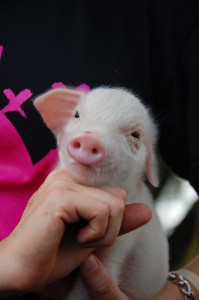The world’s largest hog producer, Murphy-Brown LLC, recently installed EPI Air in its Circle Four commercial nurseries in Milford, Utah. After only 5 months, 600,000 nursery pigs treated with EPI Air generated an additional $1,896,000 in profit. Based on 194,000 nursery spaces, the enhanced clean air environment created by EPI Air added $3.16 per pig placed.
Tag: EPI
Ten Reasons to use EPI Air in your Barn
If you are a swine or poultry producer who wants to improve your production rates, it is time to learn about Electrostatic Particle Ionization (EPI) by Baumgartner Environics. EPI is a patented air-cleaning system, specially designed for reducing dust particles from agricultural settings and other confined spaces. Read more about how it works here.
Why use EPI to Improve your In-Barn Air Quality?
- Proven Dust Removal – USDA Studies and other test data show that EPI Air can help remove 50-80% of dust particles and aerosols from the air.
- Improve Animal Production – EPI Air has been shown to dramatically improve animal production and livability (See Murphy-Brown’s production gains).
- Employee Work Environment & Morale – Cleaner air makes it easier for employees to breathe inside the animal production area, creating a better work environment.
- Quick Return on Investment – Murphy-Brown calculated less than 34 weeks to get a ROI based on their own 99.9% statistically significant tests.
- Reduce Odors for Neighbors– EPI Air catches dust particles inside the barn, so gases and pathogens can’t “hitch a ride” on dust particles being emitted outside. Visitors and neighbors will appreciate reduced barn odors.
- Encourage Growth – Cleaner air can also relieve stress on animals, creating an environment that improves the rate of swine and poultry growth.
- Reduce Mortalities – EPI Air has been shown to reduce mortality rates (Mortalities reduced by 26.1% for Murphy-Brown).
- Innovative Combinations – EPI Air can be combined with other clean-air methods such as filtration for promising results.
- Fight PRRS – EPI Air may help PRRS infected pigs to fight secondary complications.
- Worldwide Recognition– EPI Air is installed in barns across the globe. In fact, EPI complies with European standards for dust reduction with Certification in the Netherlands, and also has been invested in by the Canadian government in support of the Manitoba Pork Council.
If you would like to learn more about how EPI Air can make a difference in your production facility, please contact us today.
Clean Air at the Allen D. Lehman Swine Conference
Leaders from the swine industry across the globe will be coming to the beautiful state of Minnesota this weekend. They are coming not just to see the beautiful fall colors, but to attend an internationally acclaimed Swine Conference. The Allen D. Lehman Swine Conference, put on by the University of Minnesota Veterinary Medicine’s continuing education program, will be at the St. Paul River Centre in St. Paul, Minnesota on Sept. 15-18, 2012.
 Allen D. Lehman was a University of MN Extension Veterinarian who initiated the conference in 1974 to give practitioners a forum to discuss important issues in the swine industry. Lehman worked to define the links between swine disease and swine production. After Lehman’s death in 1994, the conference was renamed in his honor for his dedication to education in practicing veterinarians. Today, hundreds of participants from over 20 countries attend.
Allen D. Lehman was a University of MN Extension Veterinarian who initiated the conference in 1974 to give practitioners a forum to discuss important issues in the swine industry. Lehman worked to define the links between swine disease and swine production. After Lehman’s death in 1994, the conference was renamed in his honor for his dedication to education in practicing veterinarians. Today, hundreds of participants from over 20 countries attend.
This conference is a great place to discuss best practices, challenges, and the latest innovations in the swine industry. Besides the great conference and pre-conference programs and poster presentations, many of the attendees greatly value the networking that happens in the seminars, hallways, and exhibit hall. The staff from Baumgartner Environics looks forward to talking with veterinarians and graduate students about swine disease, swine production, and how EPI Air offers solutions through cleaning the air of dust particles for marked improvement in animal growth and livability.
Come visit us in booth #29 at the 2012 Allen D. Lehman Conference in St. Paul, MN!
Want to see the other events we are attending? View BEI’s other upcoming trade shows.
Understanding PM – Particulate Matter
There is no doubt that poultry houses have high concentrations of agricultural dust inside. According to a recent article in World Poultry.net, much of the dust in poultry barns comes from the litter and manure, down feathers, mineral crystals in urine, and feed. The article, Chickens: Negative air ionisation strongly decreases fine dust, goes on to explain how the concentration of dust inside poultry houses is directly related to the activity of the birds during light periods, especially in litter housing systems like floor housing for broilers and layers, and aviary housing for layers.
Dust is PM – Particulate Matter
High concentrations of dust are often referred to as “Particulate Matter” or PM. The concentration of PM is measured in terms of their size in diameter in micrometers. According to the EPA, the size of dust particles is directly linked to their potential for causing health problems.
PM 10
Dust or particulate matter with a size smaller than or equal to 10 micrometer in diameter, but larger then 2.5 micrometers in diameter, are often referred to as “inhalable coarse particles.” This particulate matter can be found near roadways and dusty industries, but also in some livestock barns.
PM 2.5
Very fine dust fraction or particulate matter below 2.5 micrometers are often referred to as “fine particles,” such as those emitted from forest fires, automobiles, and some agricultural settings. Particulate matter of 2.5 or smaller are able to pass the nose, mouth and larynx, penetrate into the thorax and some even into the lung tissues, causing adverse respiratory and cardiovascular health effects.
How to Remove Dust from Barns
Agricultural research teams have been working on developing technology for the reduction of dust exposure in poultry facilities. One such technology is EPI Air, which uses electrostatic particle ionization to emit electrons that charge dust particles that are in the air. The negatively charged particles then collect on the grounded surfaces in the barn, which is cleaned like normal after the growing cycle is complete. Studies by Murphy-Brown have shown significant reduction in particulate matter (57.7% reduction of 10-micron size, 47.4% reduction of 2.5 micron size, 43.1% reduction of .05 micron size) as well as a variety of production gains.
Contact Baumgartner Environics today to learn more about removing agricultural dust with EPI Air.
Canadian Government Invests in EPI Project to Improve Air Quality in Manitoba Swine Barns
The government of Canada recently announced in a press release dated May 23, 2012, that an investment of over $200,000 has been made that will help Manitoba pork producers. The investment, made by the government of Canada, will be able to improve the health of hog herds and boost the bottom lines for those in the hog industry.
The investment is in two projects and is in support of the Manitoba Pork Council. Member of Parliament Merv Tweed (Brandon–Souris), on behalf of Agriculture Minister Gerry Ritz stated in the press release, “Our government is committed to the long-term viability of the hog industry in Manitoba and supports measures that will keep it profitable.” He goes on, “This investment will help improve animal health in the sector and grow long-term economic prosperity for our hog producers.”
The main project they are investing in with over $150,000 is to help improve the air quality of swine barns. They will be testing the effectiveness of an electrostatic space charge system (ESCS), which is also commonly known as electrostatic particle ionization (EPI). ESCS/EPI can reduce and prevent the airborne transmission of porcine reproductive and respiratory syndrome (PRRS). PRRS is a highly infectious and deadly virus in swine that is reported to cost the Canadian industry an estimated $130 million per year.
The second investment will be used to perform a comparative study of cropping systems to promote the use of swine manure on Manitoba farms, with the hopes of identifying sustainable land management practices and lessen environmental impact.
Karl Kynoch, Chair of the Manitoba Pork Council stated, “As well, we are always looking for ways of improving air quality in barns and to find better disease prevention techniques. We also need to meet the provincial government’s regulatory process, and we believe these research projects can assist us in these goals.”
These projects are being funded by the Canadian Agricultural Adaption Program (CAAP). The regional component of CAAP in Manitoba is the Canadian Agricultural Adaption Program(MRAC).
Read the full Press Release “Government of Canada Supports Manitoba Hog Industry”
“Today in America” features EPI (Video)
EPI was recently featured in “Today in America”, with a video hosted by Terry Bradshaw. “Today in America” headlines innovative products and news from businesses, inventors, and leaders across the United States. John and Matt Baumgartner of Baumgartner Environics, and Steve Pollman and Chris Rademacher of Murphy-Brown LLC explain how EPI (Electrostatic Particle Ionization) results in cleaner, healthier air, providing a better work environment for all involved including animals and workers alike.

If you would like to learn more about how EPI could benefit your livestock, call Baumgartner Environics at 800-823-4234, fill out this simple form, or comment below.
Swine Solutions: Clearing the Air
Hubbard Feeds, based out of Mankato, Minnesota, is a leader in providing nutrition and feed for swine and other animals. Their focus on educating producers about the ties between health and performance of swine is evident through the resources, such as podcasts and newsletters, that they offer their dealers on their website.
In the March 2012 issue of their Swine Solutions Newsletter, Hubbard wrote an article called “Clearing the Air – Negatively Charged Ions Improve Barn Air Quality and Pig Growth”. The article informs the livestock producers that beyond animal nutrition, air quality in the animals’ barn is also important to their health. The technology they describe for controlling dust emissions is called EPI (Electrostatic Particle Ionization) and is manufactured by Baumgartner Environics.
The article showcases what both New Fashion Pork and Murphy-Brown have already experienced with EPI – that dust reduction translates to better performance. Dr. Chris Rademacher of Murphy-Brown explains what happens when young pigs inhale dust, “…it robs pigs of some of the energy and nutrients we’re supplying for growth.”
But the benefits of EPI are not just for the animals. There is also an advantage to the surrounding community, as described by John Baumgartner, President of Baumgartner Environics. “If you take 50% or more of the dust out of the air, that’s emissions that never leave the barn, it’s not going out the fan and getting into the outside environment.”
Livestock producers need to be proactive with environmental issues, now more then ever. EPI Air provides an easy and cost effective way to improve agricultural air quality issues.
Read the Complete Article “Clearing the Air” in Hubbard’s Swine Solutions Newsletter
